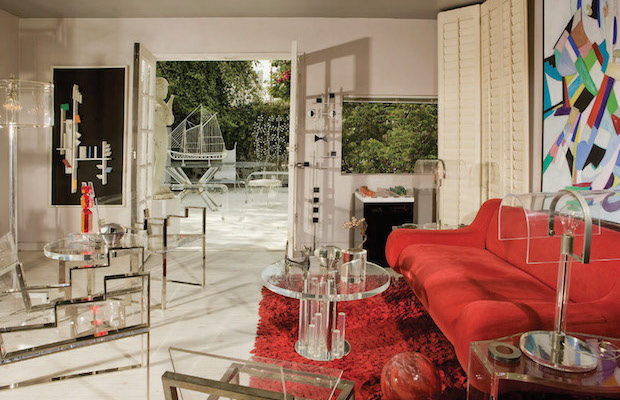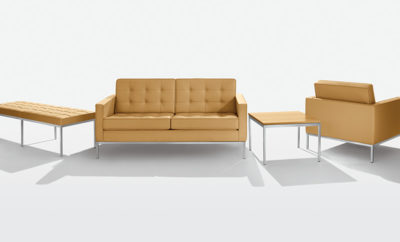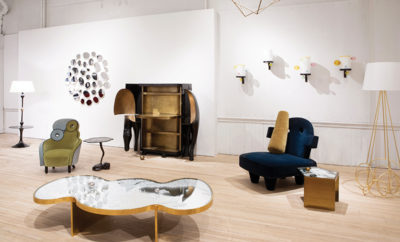 MARY E. NICHOLS PHOTO
MARY E. NICHOLS PHOTO
Feature
Clear & Present Design
IT IS ON THE EDGE OF POSSIBILITIES that designer Charles Hollis Jones finds his greatest inspirations, where he cuts through the clutter, dials down the cacophony, and finds the clarity that guides his thinking. At first, Jones was attracted to the optical properties of glass but found the material too limiting because of its fragility. Then he discovered plastics and decided that acrylic would be his material of choice—a decision that has spawned more than twenty-five lines of furniture, accessories, and architectural elements over the course of some fifty years. Focusing on this underutilized material for furnishings, Jones developed a signature style in acrylic and metal that is recognized for its elegant arrangements of the boldest, most elemental geometric shapes—circles, squares, and triangles—in precise and refined combinations.
Through years of research, experimentation, and innovation that resulted in proprietary manufacturing processes, Jones mastered the art of bending, stretching, twisting, joining, and casting acrylic into illusionistic furniture and accessories that function beautifully in both domestic and public spaces. He achieves this by exploiting the optical properties of clear acrylic and by outlining the fluid contours of his transparent constructions in reflective polished nickel, chrome, or brass frames.
The effect is magical: as one moves around Jones’s furniture one sees through to the sides and edges, each view representing the contour of the completed design. Examples of this phenomenon are the Waterfall line’s Sling chair and Veronica boudoir chair, in which the thinly stretched acrylic forming the back and seat seems to disappear into the air. The continuous bent acrylic fools the eye into thinking that the chairs are weightless and without substance, subverting the reality of their solidity, tensile strength, and tactility. In fact, it is only through their supporting metal frames that the chairs are “exposed.” Jones amplified this idea in the V line’s W chair and the Waterfall line’s Harlow chair, where the metal support structures are eliminated, making the chairs entirely see-through. In a room setting their physical structure seems to dissolve and they become points of light.

View of the living room in Jones’s residence, c. 2004. The sofa with lighted platform base, c. 1968, was designed for TV game show host Monty Hall. On the flanking tables are “Let’s Make a Deal” lamps, c. 1963, and in front of the sofa is a coffee table from Jones’s Post line, 1965, in acrylic and polished nickel over steel. At left are a pair of Tumbling Block lounge chairs, 2000, acrylic and polished nickel; a Ziggurat table, 1984, in acrylic and polished nickel (from a series originally designed for Le Mondrian hotel in Hollywood); and a Ziggurat floor lamp, 1965, in acrylic and polished nickel. Starburst, an oil painting by Elizabeth Keck, 1985, hangs above the sofa. MARY E. NICHOLS PHOTO
There is always a sense of enchantment in the interplay of reflection and transparency: one imagines that the designer, like the storybook character in Harold and the Purple Crayon, has drawn the outline of a chair, table, or lamp in space and coaxed it into becoming a thing of weight and volume through pure trickery. But it would be a mistake to dismiss Jones’s designs as mere parlor tricks. The underlying principles on which they are based run deep.
At their root, his designs are planted firmly in his youth on the family farm on Popcorn Road in a small town near Bloomington, Indiana, where he was born in 1945. Surrounded by farm equipment and assigned the task of tending the dairy cows, Jones experienced firsthand how form follows function in farm machinery; and he also learned the value of a hard day’s work. His talent for design was revealed at an early age in his Erector Set creations and his precocious pencil sketches of cars (for Jones, automobile design has been a lifelong passion). He recollects that he designed and built his first piece of furniture at the age of fourteen: a plywood cabinet for his father’s office. By the age of sixteen he was designing furniture and domestic goods for Roide Enterprises, a Los Angeles acrylic business that retailed its designs at high-end department stores such as Bullock’s Wilshire in Los Angeles.

Patio of Jones’s residence, c. 2004. The Truss dining table from the Post line, c. 1970, in acrylic and chrome is flanked by a pair of Waterfall line benches, 1970, in acrylic. Jones’s dog Shyla sits on a Wisteria chair from the Blade line, designed for Tennessee Williams, 1968, in acrylic with upholstered cushion. The ship sculpture on the table is by Curtis Jeré. MARY E. NICHOLS PHOTO
Jones had met Roide on a visit to Los Angeles during a summer vacation in 1961 and soon determined that L.A. was the place to make his mark as a designer. After finishing high school, he left the Indiana farm and set off on his own course, settling in Los Angeles, where he secured a job as a driver and delivery boy for Hudson-Rissman, a well-appointed design and accessories showroom. While learning the design business, he worked his way up through the ranks. His design career was formally launched in 1968 when he was appointed head of the design team at the Hudson-Rissman showroom. He held this position until 1974 and within three years of leaving Hudson-Rissman had established his own showroom in the fashionable Los Angeles design district. From the mid-1970s through early 1980s, several of his furniture designs were represented by the Swedlow Group in a line marketed as the Charles Hollis Jones Signature Collection and Signatures in Acrivue.
Throughout his approximately fifty years in practice, Jones’s furnishings have been placed in high-profile residential environments created by some of the leading architects, designers, and interior decorators of the twentieth century, among them Paul László, John Lautner, Arthur Elrod, Stephen Chase, Hal Broderick, and John Elgin Woolf.

Living room in the residence of Edward Cole and Chris Wigand, Palm Springs, 2016. The furniture includes pieces from the Waterfall line, namely: a pair of Bear sofas with lighted acrylic bases, 1970; four Double Waterfall Pillow chairs, acrylic and polished brass over steel, 2006; and a coffee table, acrylic, 1983. The area rug is by Edward Fields. TONY PINTO PHOTO
When asked later in life about influences, Jones cited his father’s adjunct trade as a restorer of wooden covered bridges in Indiana and his mother’s homespun skills as a quilt maker, and indeed, in distinctive ways, both parents provided creative inspiration for his designs. The sleek, visual forms that feature transparent construction and achieve a bold, graphic effect of silhouette derive, in part, from watching his father work. “I saw so many bridges exposed to the bones of their frames,” Jones recalls. The experience gave him not only an understanding of the underlying structural framework but also an appreciation of the stark beauty and strength revealed in a bridge’s complex uncovered forms. The designs of the Metric lounge chair and ottoman (1965) most overtly exploit this concept of exposed infrastructure, with steel and acrylic meeting at right angles to connect the frame. Jones’s acrylic furniture is all about refined profiles and dynamic sweeping lines that make the pieces appear to float above the ground—in homage to the bridge. The intricate patterns of his mother’s hand-stitched quilts also contributed to Jones’s early aesthetic education and helped shape his design vocabulary. He would later translate this visual information onto drafting paper, conceptualizing and inscribing the geometric outlines that would come to define his work. This is most readily apparent in the bowed arch shape of the Crescent chair (2009)—a translation of the Cathedral Window quilt pattern; in the Tumbling Block chair (2000), the profile of which is inspired by the Log Cabin and Tumbling Block patterns; and in the rocking chair in Jones’s O line (2008), an interpretation of the popular Double Wedding Ring quilt pattern.
Jones’s childhood experiences fueled his intellectual curiosity for all things design. His Apple chairs and Tree of Life bed (2000)—both from the Tree line—remind us that the Indiana farm is never far from his drafting board.

Apple chair, Tree line, 2010, acrylic and polished nickel over steel.
Designed in homage to his father’s work with wood, the Tree line demonstrates Jones’s objective to connect his designs back to nature. The twisted, branchlike elements that stretch up and over the arms and back of the chairs, and the spiraling branches that grow upward and extend beyond the top of the bed to mimic a canopy, evoke a sensation of wild, uncontrollable growth. And the dangling apple is the ultimate design tease, pregnant with symbolism. But for Jones, this design returned him solidly to his roots as the son of Indiana farmers. Although he arrived in Los Angeles some fifty years ago and has made the city his home and the location of a successful career, he will be the first to tell you that his experiences growing up on the family farm still surge through his veins, and that his oft-referred-to “international luxe” style is “as American as apple pie.”
Charles Hollis Jones: Mr. Lucite, containing an essay by Jo Lauria, is due to be published by the Lancaster Museum of Art and History in Lancaster, California, and AC Projects in February 2017.

W chair, V line lounge set, 2010, acrylic. COURTESY CHARLES HOLLIS JONES ARCHIVE
You may also like...
E-NEWSLETTER
Advertisement
Advertisement

MODERN Magazine takes a fresh and intelligent approach as it examines buildings and interiors, furniture and objects, craft and art—delving into the creative process and offering sage advice for both the seasoned and novice collector or connoisseur.
© 2019 MODERN Magazine Media, LLC
LATEST NEWS
-
 DAVID SOKOL | April 29, 2019
DAVID SOKOL | April 29, 2019Method & Concept Shakes Up the Design Scene in Naples
Chad Jensen opened Method & Concept in Naples, Florida, in 2013 according to the Art Basel Miami Beach...
-
 ADRIAN MADLENER | April 24, 2019
ADRIAN MADLENER | April 24, 2019Collectible Milan
The annual Milan Design Week has long been the established benchmark of the industry. Comprised of the massive...
-
 JUDITH GURA | April 22, 2019
JUDITH GURA | April 22, 2019Breakout Efforts at the Corning Museum of Glass
Those who don’t consider glass a major art medium will think again after visiting a fascinating exhibition that...
-
 ANNA K. TALLEY | April 18, 2019
ANNA K. TALLEY | April 18, 2019Designers Envision the Future of Water at A/D/O
For Jane Withers, the London-based curator and writer who led Water Futures, design incubator A/D/O’s latest initiative, this...
-
 MATTHEW KENNEDY | April 18, 2019
MATTHEW KENNEDY | April 18, 2019Delving Deeper
Why an uncharacteristically meditative Memphis design mesmerized one resourceful bidder
-
 EZRA SHALES | April 16, 2019
EZRA SHALES | April 16, 2019Design Destination: Stockholm
TO STROLL ALONG STOCKHOLM’S HARBORS is to inhale the essentials of the city’s largesse and welcoming grandeur: the...





